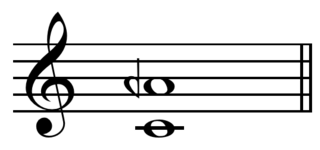Loading AI tools
Musical interval From Wikipedia, the free encyclopedia
A neutral sixth is a musical interval wider than a minor sixth but narrower than a major sixth . Three distinct intervals may be termed neutral sixths:
| Inverse | neutral third |
|---|---|
| Name | |
| Other names | - |
| Abbreviation | n6 |
| Size | |
| Semitones | ~8½ |
| Interval class | ~3½ |
| Just interval | 18:11[1] or 13:8[2] |
| Cents | |
| 12-Tone equal temperament | N/A |
| 24-Tone equal temperament | 850 |
| Just intonation | 853 or 841 |

These intervals are all within about 12 cents of each other and are difficult for most people to distinguish. Neutral sixths are roughly a quarter tone sharp from 12 equal temperament (12-ET) minor sixths and a quarter tone flat from 12-ET major sixths. In just intonation, as well as in tunings such as 31-ET, 41-ET, or 72-ET, which more closely approximate just intonation, the intervals are closer together.
A neutral sixth can be formed by subtracting a neutral second from a minor seventh. Based on its positioning in the harmonic series, the undecimal neutral sixth implies a root one minor seventh above the higher of the two notes.

The pitch ratio 13:8 (840.53 cents) is the ratio of the thirteenth harmonic and is notated in Ben Johnston's system as A13♭. In 24-ET is approximated by A![]() . This note is often corrected to a just or Pythagorean ratio on the natural horn, but the pure thirteenth harmonic was used in pieces including Britten's Serenade for tenor, horn and strings.[4]
. This note is often corrected to a just or Pythagorean ratio on the natural horn, but the pure thirteenth harmonic was used in pieces including Britten's Serenade for tenor, horn and strings.[4]
Seamless Wikipedia browsing. On steroids.
Every time you click a link to Wikipedia, Wiktionary or Wikiquote in your browser's search results, it will show the modern Wikiwand interface.
Wikiwand extension is a five stars, simple, with minimum permission required to keep your browsing private, safe and transparent.